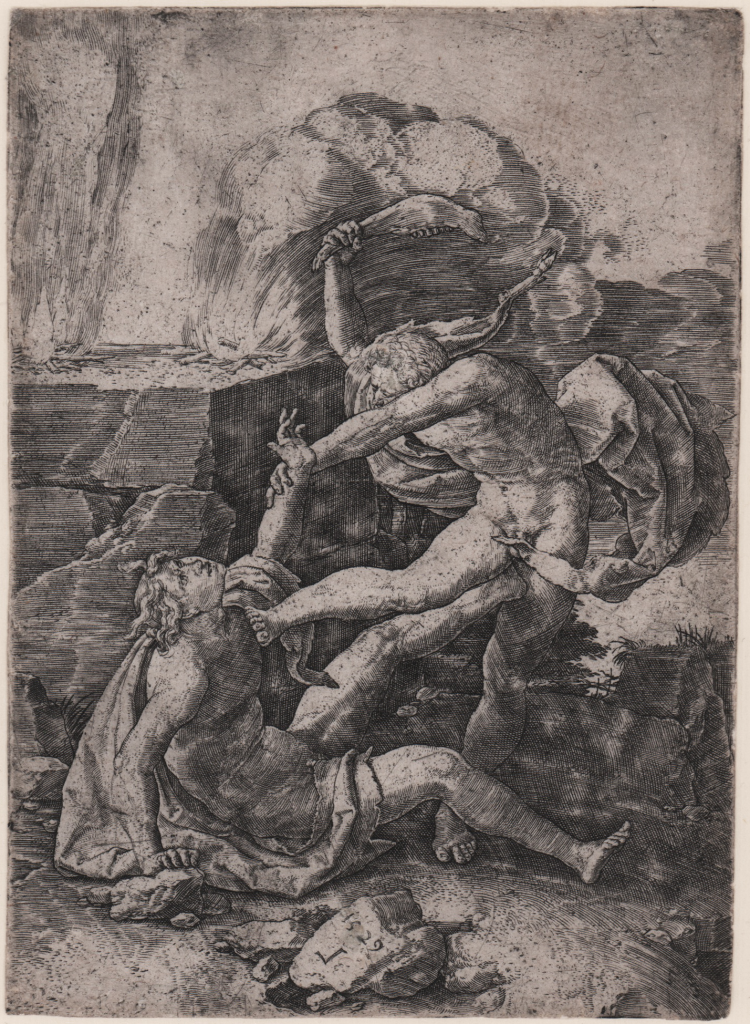




| Reference: | S37953 |
| Author | Lucas van LEYDEN |
| Year: | 1529 |
| Measures: | 119 x 163 mm |



| Reference: | S37953 |
| Author | Lucas van LEYDEN |
| Year: | 1529 |
| Measures: | 119 x 163 mm |
Cain Killing Abel; Abel is forced to the ground by Cain whose right foot pushes against Abel's chest; Abel raises his left arm to defend himself while Cain brandishes a jawbone in his right hand above his head; two fires burn on the stone altar to the left.
Engraving, 1529, lettered with the date 1529 and letter "L" in reverse on a rock in the center foreground. Example of the first state of three described by Hollstein, before the address of M. Petri (Peeters); a second issue (Ib) with minor spots and schratches.
The fifth in a series of six plates depicting the Story of Adam and Eve.
This scene is linked to Genesis 4:8; Jealous Cain kills his brother Abel. Behind them the fires they used for their offerings are still burning.
A very good impression, printed on contemporary laid paper, trimmed close to platemark, in good condition.
Bibliografia
New Hollstein (Dutch & Flemish) / The New Hollstein: Dutch and Flemish etchings, engravings and woodcuts 1450-1700 (5.I); Bartsch / Le Peintre graveur (VII.340.5).
Lucas van LEYDEN (Leida 1494 - 1533)
|
Named either Lucas Hugensz or Jacobsz, was a Dutch engraver and painter, born and mainly active in Leiden, who was among the first Dutch exponents of genre painting and is generally regarded as one of the finest engravers in the history of art. He was the pupil of his father, whose works are unknown, and of Cornelis Engelbrechts. They were both painters whereas Lucas himself was principally an engraver. Where he learnt engraving is unknown, but he was highly skilled in that art at a very early age: the earliest known print by him (Mohammed and the Murdered Monk) dates from 1508, when he was perhaps only 14, yet reveals no trace of immaturity in inspiration or technique.
In 1514 he entered the Painters' Guild at Leiden. He seems to have travelled a certain amount, and visits are recorded to Antwerp in 1521, the year of Dürer's Netherlandish journey, and to Middelburg in 1527, when he met Gossaert. An unbroken series of dated engravings makes it possible to follow his career as a print-maker and to date many of his paintings, but no clear pattern of stylistic development emerges. Dürer was the single greatest influence on him, but Lucas was less intellectual in his approach, tending to concentrate on the anecdotal features of the subject and to take delight in caricatures and genre motifs. Carel van Mander characterizes Lucas as a pleasure-loving dilettante, who sometimes worked in bed, but he left a large oeuvre, in spite of his fairly early death, and must have been a prodigious worker.
|
Lucas van LEYDEN (Leida 1494 - 1533)
|
Named either Lucas Hugensz or Jacobsz, was a Dutch engraver and painter, born and mainly active in Leiden, who was among the first Dutch exponents of genre painting and is generally regarded as one of the finest engravers in the history of art. He was the pupil of his father, whose works are unknown, and of Cornelis Engelbrechts. They were both painters whereas Lucas himself was principally an engraver. Where he learnt engraving is unknown, but he was highly skilled in that art at a very early age: the earliest known print by him (Mohammed and the Murdered Monk) dates from 1508, when he was perhaps only 14, yet reveals no trace of immaturity in inspiration or technique.
In 1514 he entered the Painters' Guild at Leiden. He seems to have travelled a certain amount, and visits are recorded to Antwerp in 1521, the year of Dürer's Netherlandish journey, and to Middelburg in 1527, when he met Gossaert. An unbroken series of dated engravings makes it possible to follow his career as a print-maker and to date many of his paintings, but no clear pattern of stylistic development emerges. Dürer was the single greatest influence on him, but Lucas was less intellectual in his approach, tending to concentrate on the anecdotal features of the subject and to take delight in caricatures and genre motifs. Carel van Mander characterizes Lucas as a pleasure-loving dilettante, who sometimes worked in bed, but he left a large oeuvre, in spite of his fairly early death, and must have been a prodigious worker.
|